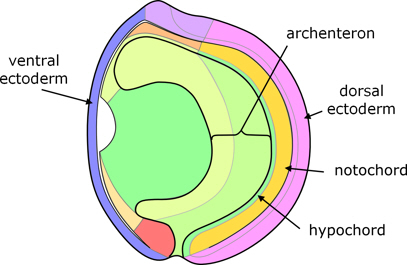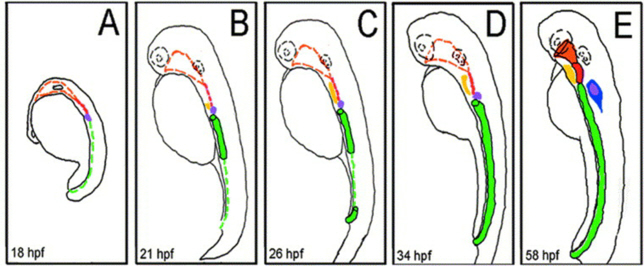A comparison of gut formation in vertebrates
The digestive tract is formed in three completely different ways in vertebrates:
- invagination of the epiblast
- fusion of endoderm folds, and
- cavitation within the endoderm.
Invagination
As mentioned in the comparison of gastrulation, the archetypal way in which the gut is formed is by development of an invagination (called the archenteron) of the outer layer of cells, that arises as part of gastrulation. For the vertebrates, this occurs only in the amphibians and some fish groups (but not the most abundant teleosts or chondrichthyans).

Figure 1. Gut formation in Xenopus.
Fusion of endoderm folds
The most common way in which the gut forms in vertebrates is by the formation and fusion of folds of endoderm, which of course occurs after gastrulation. The folds arise along the length of the embryo; fusion of the folds generally begins at the head and tail ends, and closure propagates from each end until the primitive gut tube is complete. This occurs in amniotes and chondrichthyans.

Figure 2. Gut formation in catshark.
Ancillary organs, such as the liver and pancreas, arise from the gut tube as endodermal buds or pockets that grow into mesenchyme that is closely associated with the tube. Gut endoderm gives rise to all of the digestive epithelia.
Cavitation within the endoderm
Formation of the gut in teleost fish is unusual in several ways:
1. Most significantly, it arises not by the formation and fusion of folds of endoderm, or by invagination of the endoderm, but by cavitation within the endoderm tissue.

Figure 3. Gut formation in zebrafish. [a]
2. Whereas in amniotes the ancillary digestive organs arise by development of pockets of the initial primitive gut tube, in teleosts the ancillary organs arise as independent cavitations within particular parts of the endoderm, which then connect with the main digestive tube.
3. Finally, is timing: whereas fusion of endoderm folds generally begins at the head and tail, with completion of the tube propagating towards the midgut which completes last, when formed by cavitation in teleosts, it is the midgut that forms first.
Go to Gut formation in the Overview of diverse early embryonic development of vertebrates.
Image credits
Graphics are by David Swift unless stated otherwise.
The background image for the page banner is taken from an image by ★Kumiko★ – https://www.flickr.com/photos/kmkmks/27388394090/, CC BY-SA 2.0, https://commons.wikimedia.org/w/index.php?curid=57660389
a. Figure 5 from Kenneth Wallace, Michael Pack (2003); Unique and conserved aspects of gut development in zebrafish, Dev. Biol. Mar 1;255(1):12-29. doi: 10.1016/s0012-1606(02)00034-9, Open Access.
Page created October 2020.